112 - Progress?
Thursday, July 31, 2014
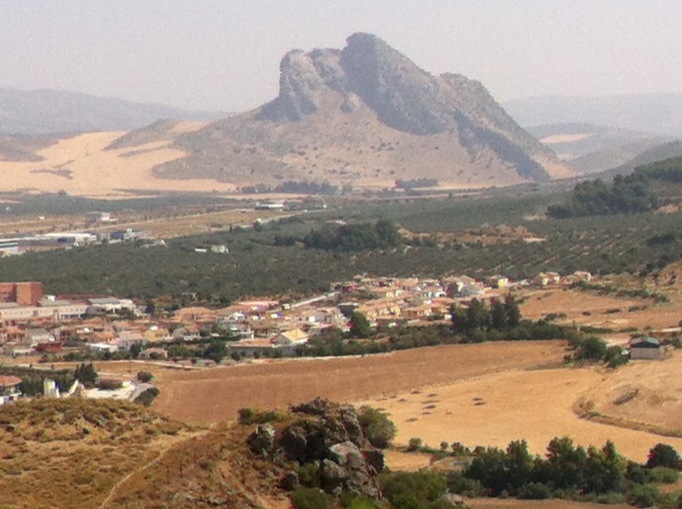 You see the famous rock near Antequera from every direction. From the flat plains it juts up, suddenly and harshly. Known to the Spanish as la Peña de los Enamorados (the lovers' rock) and to many as the Indian's Head (or Charles de Gaulle rock) it is visible for miles, a way-marker for those travelling north-south between Córdoba and Málaga, or east-west between Granada and Sevilla. You see the famous rock near Antequera from every direction. From the flat plains it juts up, suddenly and harshly. Known to the Spanish as la Peña de los Enamorados (the lovers' rock) and to many as the Indian's Head (or Charles de Gaulle rock) it is visible for miles, a way-marker for those travelling north-south between Córdoba and Málaga, or east-west between Granada and Sevilla.
Legend has it that two lovers jumped from the rock when their warring families refused to acknowledge their love. Early versions of the tale say it was a young man from Antequera and a young woman from Archidona. Other versions say it was an Arab prince and a servant girl, or a Muslim princess and a Christian slave boy. Whichever you believe, the story is clear (and sadly unchanging) - families unable to accept difference, chase their children to a tragic death.
This visit to Antequera arose from a very 21st century mistrust of scams, combined with an equally 21st century use of the internet. A phone call out of the blue asking me to take my car to a garage for a free software upgrade had rung alarm bells. Having received several of the "Hello I'm calling from Microsoft and you need to pay me lots of money to fix your computer"-type phone calls, I was a little suspicious. I shouldn't have been. A quick internet search demonstrated that SEAT cars in other countries were being recalled for a software update linked to a minor problem with the airbags. The internet even showed me a photo of the man who had called, in his SEAT uniform! So, fears allayed, I took the car to the Antequera workshop, passing as always la Peña de los Enamorados. And of course all went well and it was simply good customer service.
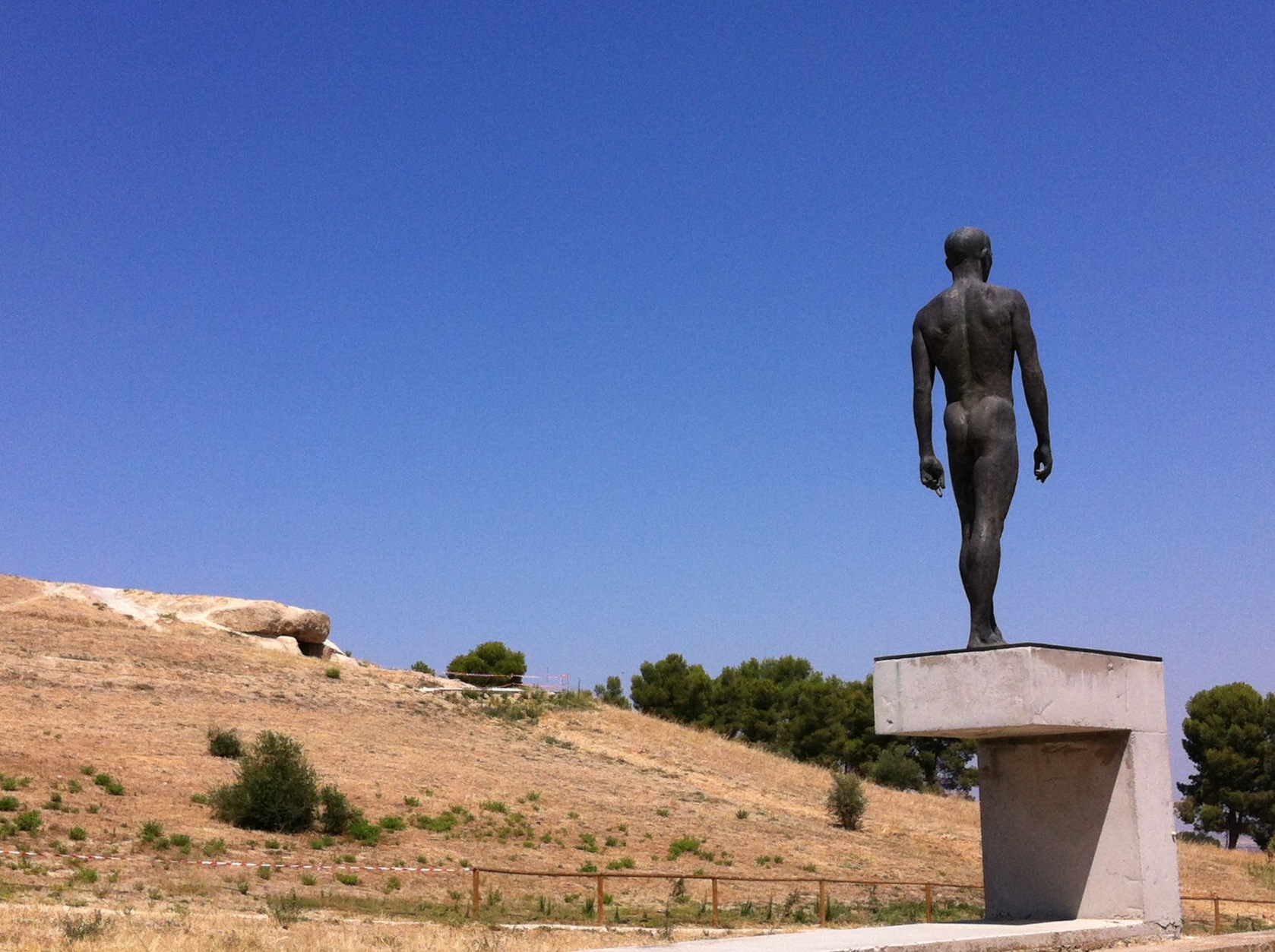 Free time in Antequera and at last a chance to visit the Dólmenes - megalithic tombs, temples, or ritual sites. A statue known as El Caminante (The Traveller) gazes implacably across the plains from near the Dolmens visitors' centre towards the lovers' rock. Created in 2005 by the artist Miguel García, he somehow manages to link the people of 6,500 years ago who lived out their lives on these plains, with modern humankind, living such extraordinarily different lives from those of our ancestors. Free time in Antequera and at last a chance to visit the Dólmenes - megalithic tombs, temples, or ritual sites. A statue known as El Caminante (The Traveller) gazes implacably across the plains from near the Dolmens visitors' centre towards the lovers' rock. Created in 2005 by the artist Miguel García, he somehow manages to link the people of 6,500 years ago who lived out their lives on these plains, with modern humankind, living such extraordinarily different lives from those of our ancestors.
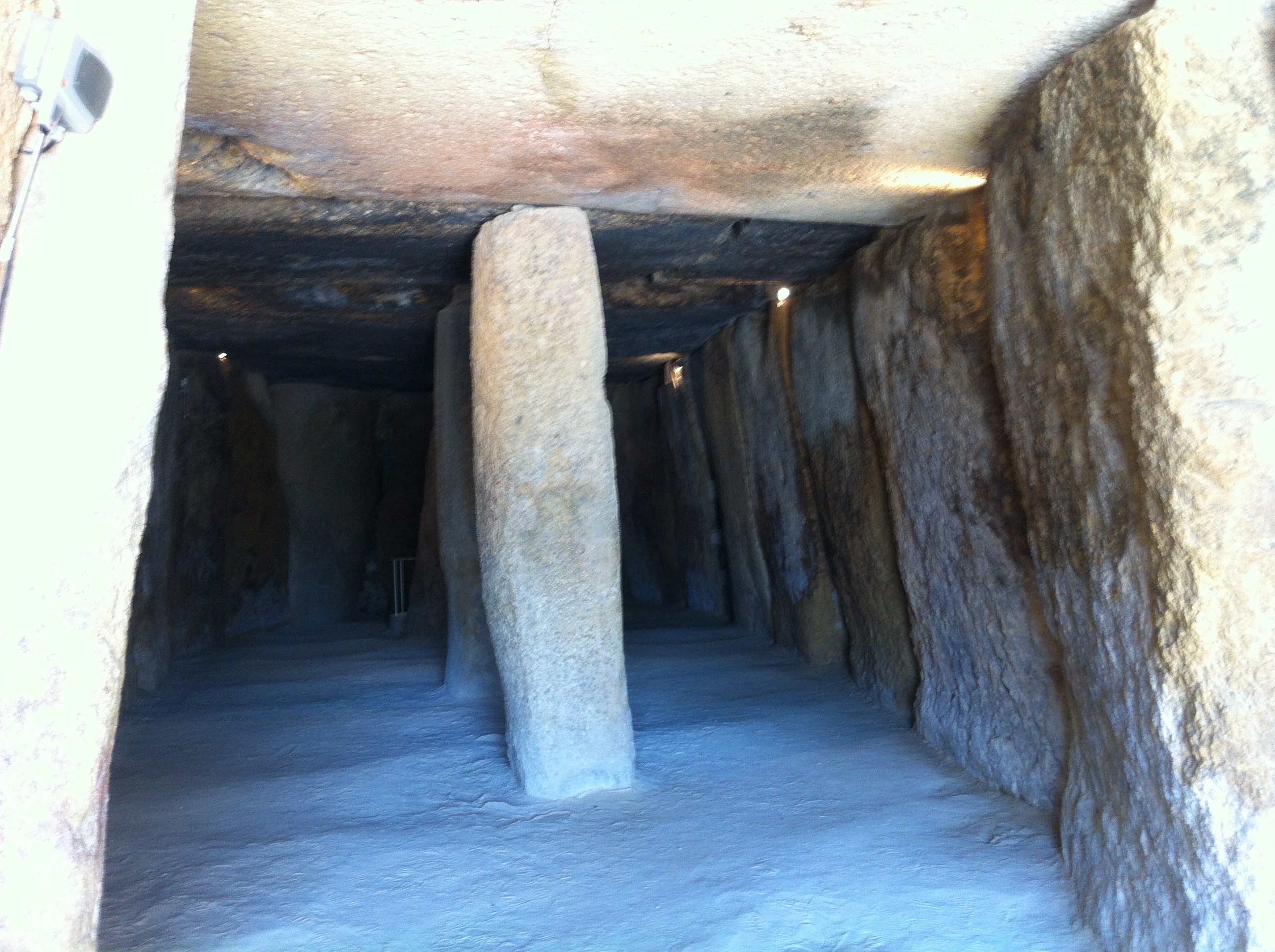 Walking between the two main tombs in the July heat you couldn't help but wonder why such labour was expended. The structures use enormous stones, in the same way that Stonehenge does (built probably 2,000 years later). It is believed that this is evidence of co-operation amongst many different local farming communities, working towards a shared goal, putting aside tribal differences to achieve something of value to all. I can't think of a modern equivalent - it seems that with greater knowledge has come an increased tribalism and a reduced ability to share or to live or work together. Perhaps these thoughts were running through my head this week in particular because of watching the devastation wreaked in Palestine and Israel. Certainly the stories of the Lovers' Rock and of humankind's unwillingness to hold hands across racial or religious divides, seem as timeless and unchanging as the rock itself. Walking between the two main tombs in the July heat you couldn't help but wonder why such labour was expended. The structures use enormous stones, in the same way that Stonehenge does (built probably 2,000 years later). It is believed that this is evidence of co-operation amongst many different local farming communities, working towards a shared goal, putting aside tribal differences to achieve something of value to all. I can't think of a modern equivalent - it seems that with greater knowledge has come an increased tribalism and a reduced ability to share or to live or work together. Perhaps these thoughts were running through my head this week in particular because of watching the devastation wreaked in Palestine and Israel. Certainly the stories of the Lovers' Rock and of humankind's unwillingness to hold hands across racial or religious divides, seem as timeless and unchanging as the rock itself.
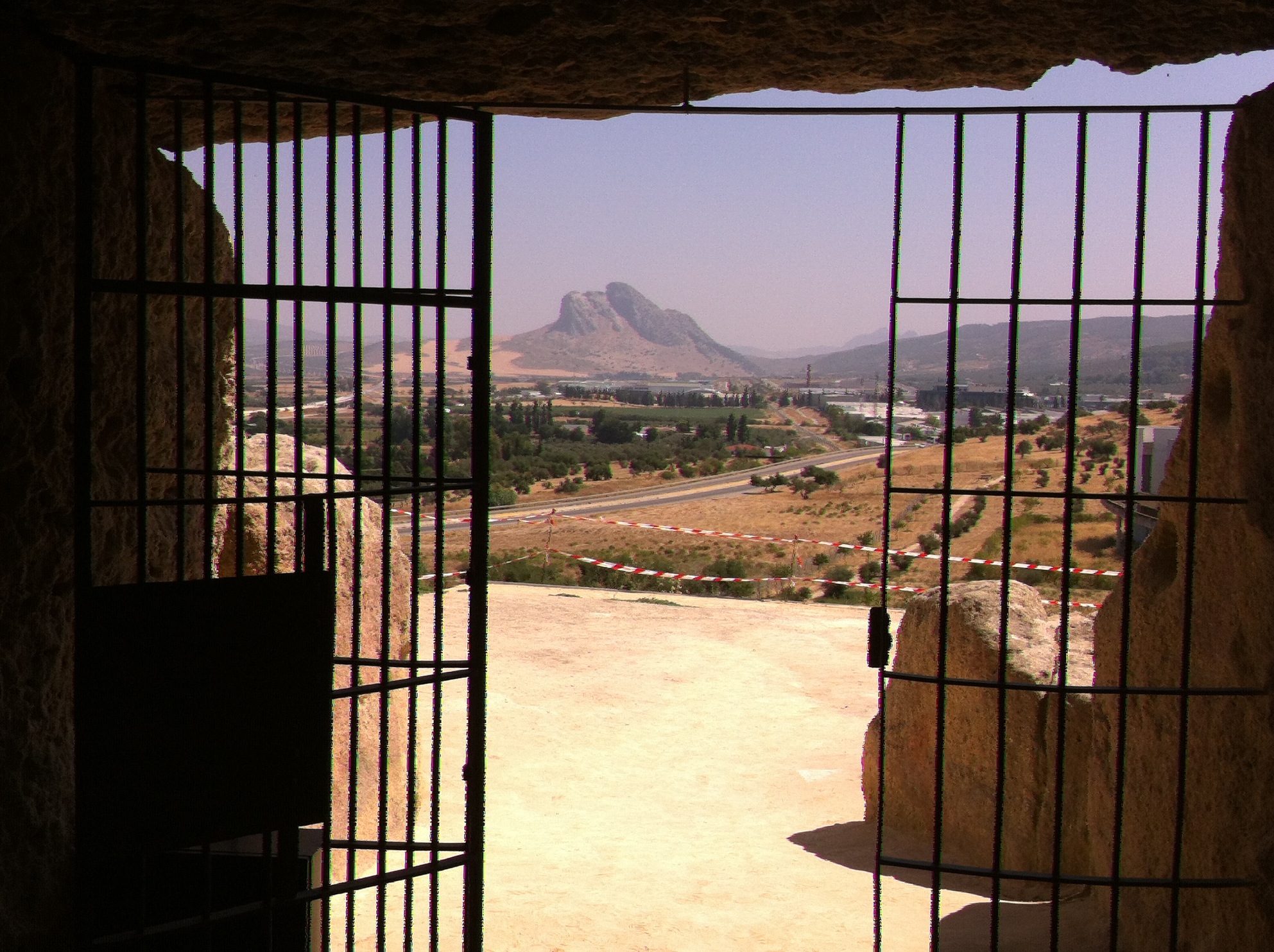 Inside the dolmens the wonder and the wondering continued. Burial sites, centres to come together to worship and to pray for good harvests .... the full explanation escaped me. Possible stories swirled through my mind as I struggled to imagine their lives, 6,500 years ago. Children, adults, farming, learning, eating together, playing together, and all the time gazing at the Lovers' Rock, just as hundreds of thousands of modern people do every day, if they remember to look up from their iPads and Androids. Inside the dolmens the wonder and the wondering continued. Burial sites, centres to come together to worship and to pray for good harvests .... the full explanation escaped me. Possible stories swirled through my mind as I struggled to imagine their lives, 6,500 years ago. Children, adults, farming, learning, eating together, playing together, and all the time gazing at the Lovers' Rock, just as hundreds of thousands of modern people do every day, if they remember to look up from their iPads and Androids.
Modern technology got me here - the internet allayed my suspicions, and the sat-nav led me to the SEAT workshop on an industrial estate and then to the dolmens. Progress, of course. I am happy to take advantage of the technological advances available to me. And it would be ridiculous to say that the "simpler" life of those farmers 6,500 years ago was anything to be hankered after. But somehow walking here and thinking of how much has changed in these six or seven millennia, makes me acutely aware of the new technologies and their capacity for both good and evil. Of course communities, races, tribes, have always fought. They fought each other for survival, for shelter, for food. But wars nowadays are not for those basics, most of the time (except for the besieged in occupied territories). Wars now are for land, for oil, for dominance, and for the imposition of one set of beliefs over another. The technology we have at our disposal is used to kill at great distances, and the mass media is used to spread misinformation, and to create distrust of difference. Call me naive, but if this is progress, could it not be used better?
* * * * * * * * * * * * * * * *
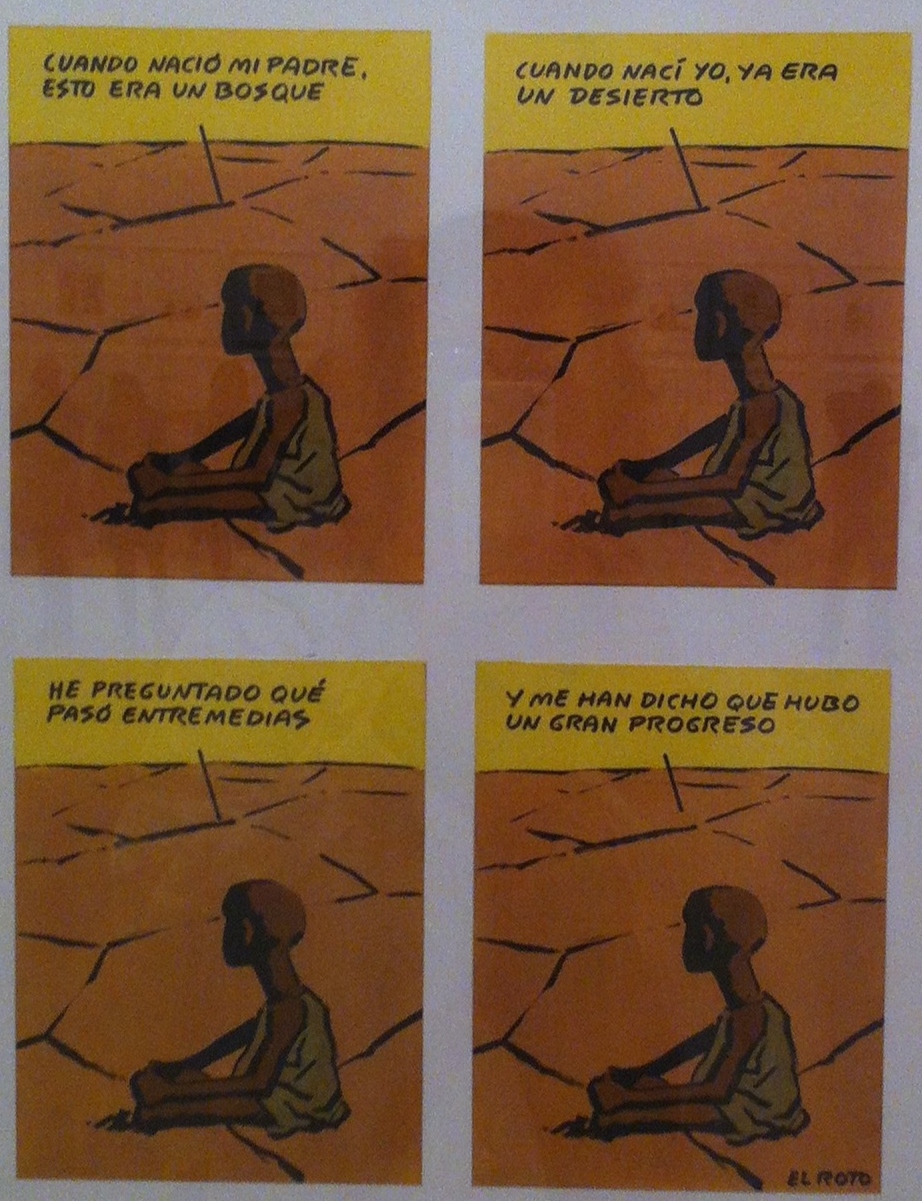
I make no apology for using this picture a second time. It’s by the cartoonist of “El País”, Andrés Rábago, who draws under the pseudonym “El Roto” (the broken).
The child is saying “When my father was born, all this was woodland. When I was born, already it was a desert. I asked what had happened in between. And they told me there had been great progress.”
© Tamara Essex 2014 www.twocampos.com
THIS WEEK'S LANGUAGE POINT:
Saying things are pointless, not worth it etc.
No sirve de nada / De nada sirve – It’s no use, it’s no good.
No sirve de nada preocuparse en ello – It’s no use worrying about it.
De nada sirve persuadirme – It’s no good trying to persuade me.
No tiene sentido tener un coche si nunca lo usas – It’s makes no sense to have a car if you never use it.
Vivo solo un paseo de aquí y por tanto no merece la pena coger un taxi – I only live a short way from here so it’s not worth getting a taxi.
No merecía la pena ir a la cama / irse a la cama / irnos a la cama – It wasn’t worth going to bed.
 0
Like
Published at 10:35 PM Comments (0)
0
Like
Published at 10:35 PM Comments (0)
111 - Lighting-Up Time
Friday, July 18, 2014
It's hot. July and August in Spain - it's hot. Seriously hot. 40°C is forecast for today.
So at around 6 or 7pm there's nothing better than firing up the barbecue.
.jpg) Out in the campo, it means perhaps scraping some of the dirt off the ancient parilla (grill) that has sat outside, unwashed, for almost a year, but probably it just means lighting the twigs beneath the charcoal and letting the heat burn off last summer's remnants. After all, it’s already been sterilised under the blazing sun. Out in the campo, it means perhaps scraping some of the dirt off the ancient parilla (grill) that has sat outside, unwashed, for almost a year, but probably it just means lighting the twigs beneath the charcoal and letting the heat burn off last summer's remnants. After all, it’s already been sterilised under the blazing sun.
The ritual begins with the trip to the butcher. A slab of tira de asado (big Argentinian-style beef ribs), a thick chunk of entraña (Argentinian if possible but Spanish is of course easier to get) to be cooked WITH the membrane on to conserve the juices, and some good chorizo sausages. Maybe some costillas cortadas (little pork ribs) to nibble on as a starter. Big calabacines (courgettes) from the neighbour's campo, superb for char-grilling. Baked potatoes wrapped in foil for warming beside the flames. Perhaps a bowl of porra and crusty bread. Salad. I make a tasty dressing made with olive oil from the neighbours opposite, good wine vinegar, local honey, garlic, salt and pepper.
.jpg) "The Day in the Campo" is an experience. Saturday or Sunday morning in the pueblos of Andalucía, the car gets loaded up with enough food to feed a small nation. A blanket and perhaps a rickety chair are thrown in the back and the car trundles off up hitherto unseen tracks. Friends and family gather, chat, tinker with the campo house, fix a broken window or lay a few more upstairs floorboards. Turn on the water and drench the struggling crops. Check whatever is growing in the parched plot of land, pick a lettuce and a few fruit, and eat and drink together. As the sun loses its heat, the parilla is lit, and a handful of wild rosemary or thyme is grabbed and thrown on to flavour the succulent meat and vegetables. "The Day in the Campo" is an experience. Saturday or Sunday morning in the pueblos of Andalucía, the car gets loaded up with enough food to feed a small nation. A blanket and perhaps a rickety chair are thrown in the back and the car trundles off up hitherto unseen tracks. Friends and family gather, chat, tinker with the campo house, fix a broken window or lay a few more upstairs floorboards. Turn on the water and drench the struggling crops. Check whatever is growing in the parched plot of land, pick a lettuce and a few fruit, and eat and drink together. As the sun loses its heat, the parilla is lit, and a handful of wild rosemary or thyme is grabbed and thrown on to flavour the succulent meat and vegetables.
City folk with friends or family in the pueblos return to their roots for the Day in the Campo. Those without rural family connections remain mystified by it. The popular Malagueñan comedian Dani Rovira does a monologue about it – a bit difficult if your Spanish isn't fluent (parts are too fast for me!) but some of it is understandable, especially the bit about loading the car up with food! http://youtu.be/0v4jwS0K6bI
.jpg) It does feel different, cooking out in the campo. Obviously there are fire risks so only proper metal barbecue pits can be used. The land is tinder-dry and a couple of massive fires a week in the summer months damage vast swathes of forest in Málaga province, sometimes endangering people, animals and property. But with care, it's a special experience. Maybe it's the isolation, the view of the next house away across the valley, the distant sound of a dog barking or goats jangling down the hillside. Partly it's the basic facilities, the usually unfinished casita, and listening to the plans for the grand home it might one day become. Mostly, it's because there’s nothing but the sound of the cicadas, the heady scent of the vines overhead and the smoke from the barbecue. It does feel different, cooking out in the campo. Obviously there are fire risks so only proper metal barbecue pits can be used. The land is tinder-dry and a couple of massive fires a week in the summer months damage vast swathes of forest in Málaga province, sometimes endangering people, animals and property. But with care, it's a special experience. Maybe it's the isolation, the view of the next house away across the valley, the distant sound of a dog barking or goats jangling down the hillside. Partly it's the basic facilities, the usually unfinished casita, and listening to the plans for the grand home it might one day become. Mostly, it's because there’s nothing but the sound of the cicadas, the heady scent of the vines overhead and the smoke from the barbecue.
Despite the loaded car, traditionally SOMETHING is always forgotten so we improvise. Despite the house being empty during the week, the tomato plants have managed to produce small fruit with explosive flavour. Green piquillo peppers are picked and laid roughly across the grill.
.jpg) And later, as darkness falls, the distance from civilisation adds enchantment to the quiet chat over the last drinks. The fire dies, plates are rinsed and stacked, and the little campo house is left alone till the following weekend. And later, as darkness falls, the distance from civilisation adds enchantment to the quiet chat over the last drinks. The fire dies, plates are rinsed and stacked, and the little campo house is left alone till the following weekend.
© Tamara Essex 2014 www.twocampos.com
THIS WEEK'S LANGUAGE POINT:
If it were not that we need to learn our conditionals, they would become boring ….
If you’re beginning to learn the conditionals, it’s well worth looking up a poem usually attributed to Jorge Luis Borges, called “Instantes” (Moments). The whole thing is beautifully written and entirely in conditionals! It’s looking back over his life, setting out what he would have done differently.
We were set a task to write something along the same lines, about what we would have done differently in our lives. Here is a part of mine, with lots of would’ve and could’ve … English translation afterwards:
Si pudiera vivir de nuevo, yo no cambiaría mucho. Trabajaría menos, y pasaría más tiempo con mi madre, porque nunca sabría cuánto tiempo nos ha de quedar. Jugaríamos más Scrabble juntas.
Si volviera comenzar mi vida nuevamente, no cambiaría mucho, porque todos mis errores y todas mis elecciones me han hecho ser la que soy.
Solo cambiaría una cosa más. Me encanta mi vida en España, y si la hubiera descubierto antes, me habría mudado más temprano.
If I were able to live my life again, I wouldn’t change much. I would work less, and spend more time with my mother, because you never know how much time you have remaining. We would play more Scrabble together.
If I could go back and start my life anew, I wouldn’t change much, because all my mistakes and all my choices have made me who I am.
I would only change one thing more. I love my life in Spain, and if I had discovered it sooner, I would have moved here earlier.
 0
Like
Published at 9:32 AM Comments (3)
0
Like
Published at 9:32 AM Comments (3)
110 - The Wedding Present
Thursday, July 3, 2014
Actually, wedding presents were completely and utterly banned. So it wasn't a wedding present. It was just a random present for a lovely friend who happened to be getting married to another lovely friend.
Whatever it was to be called, I knew what I wanted to buy. And the joy of it was that the shop, in el Centro de Visitantes en El Torcal, was a beautiful 40-minute drive away and it was a calm June morning, not too hot but not too overcast.
Forty minutes, usually. And that's not rushing. It's such a beautiful road, winding past the thousand-year-old olive tree, through Villanueva de la Concepción, climbing slowly towards the great rocky ridge of the Torcal.
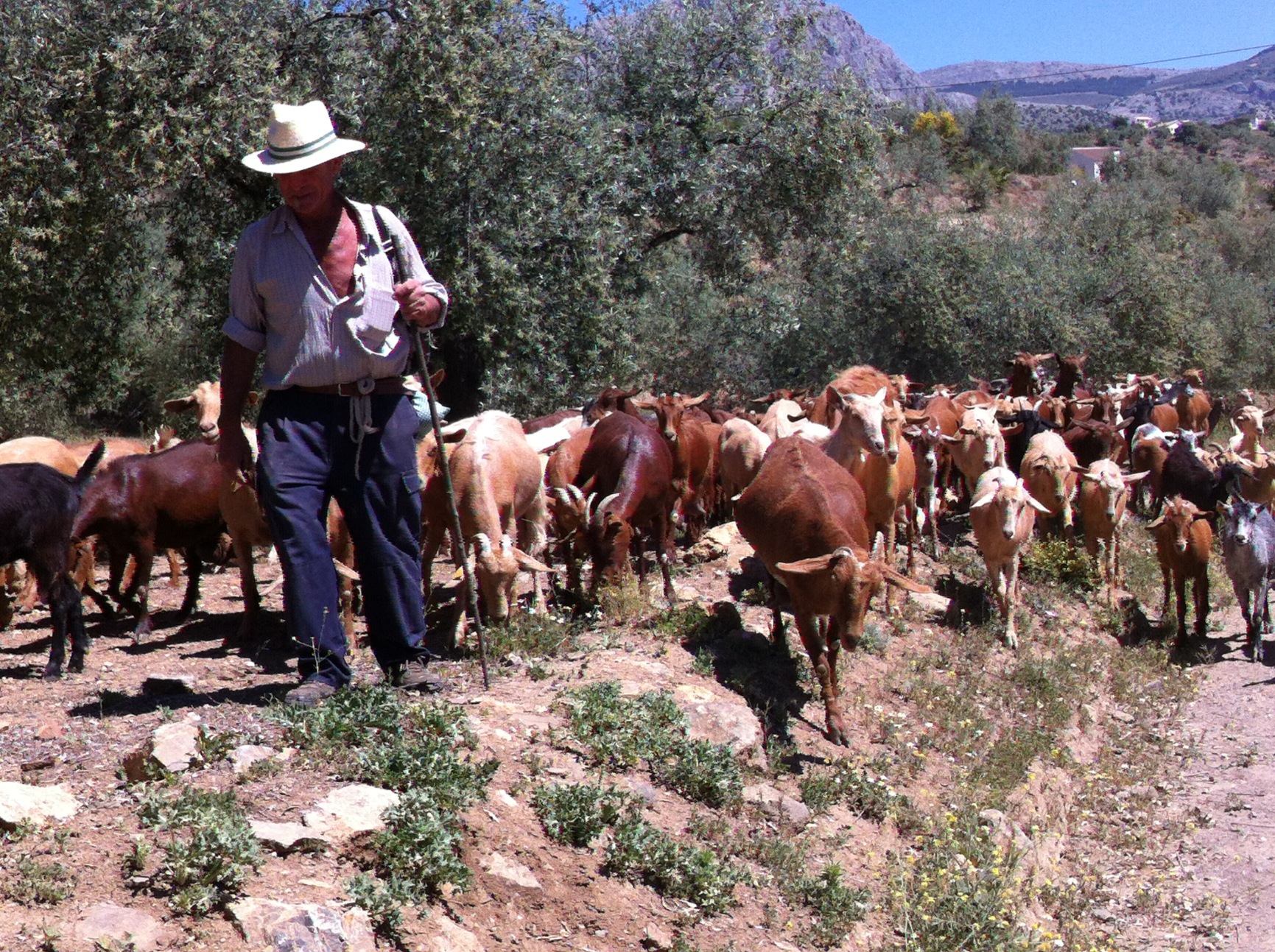 First it was goats. Well, you have to allow 8-10 extra goat-minutes on any trip that isn't wholly on the autovía. Anyway there was no rush. They were particularly lovely goats. Quite a lot of them. I turned the engine off and snapped a couple of pictures as they buffeted past. First it was goats. Well, you have to allow 8-10 extra goat-minutes on any trip that isn't wholly on the autovía. Anyway there was no rush. They were particularly lovely goats. Quite a lot of them. I turned the engine off and snapped a couple of pictures as they buffeted past.
A few kilometres on I spotted the horse looking a bit skittish by the side of the road. Sure enough, although I approached very slowly and way across on the other side of the road, it looked petrified so I stopped completely to wait for the farmer to calm it enough to get it back off the road into the scrubland. Eventually the horse stopped shaking, and I slowly inched by.
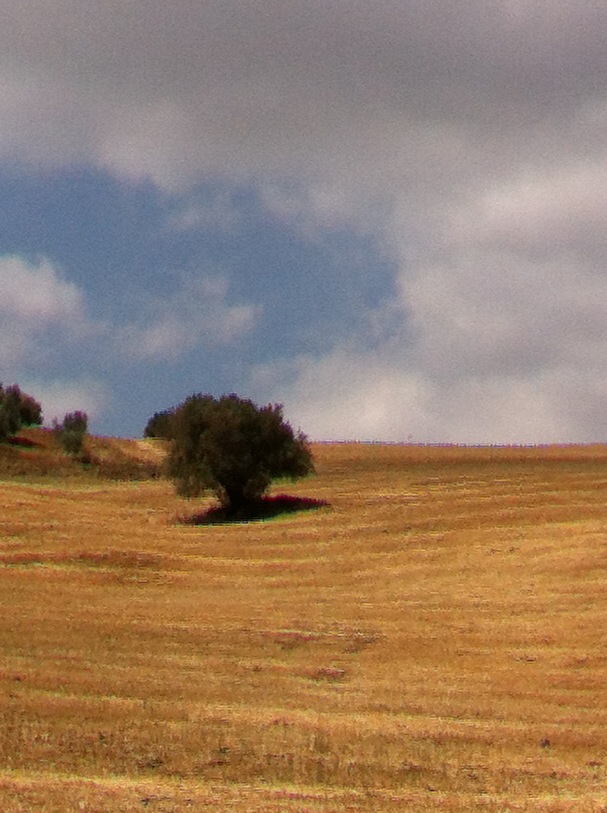 Then it was a tree. Not in the road, but a tree in a field looking particularly perfect. I love those single trees in the centre of great swathes of corn. Surely they must get in the way for ploughing? But fortunately for us all, they are allowed to remain, standing in majestic solitude guarding the crops. Then it was a tree. Not in the road, but a tree in a field looking particularly perfect. I love those single trees in the centre of great swathes of corn. Surely they must get in the way for ploughing? But fortunately for us all, they are allowed to remain, standing in majestic solitude guarding the crops.
Higher and higher, my ears popping, then more goats. For one silly second I felt a flash of irritation. Then I remembered. I had no appointment, no pressure, just a bit of shopping to do. But even more important than the shopping is to remind myself every day how beautiful Andalucía is, how stunning the countryside is, and how hard the farmers work in this glorious but harsh landscape.
So I was happy to sit again, to admire the animals. The two dogs were working and completely ignored my car. I was of passing interest to a few goats - one stuck his head in the car to see if there was anything to eat. The goat-herd tipped his hat, thanked me for waiting (as though there were other options ....) and, after a second 8-10 goat-minutes, the journey continued.
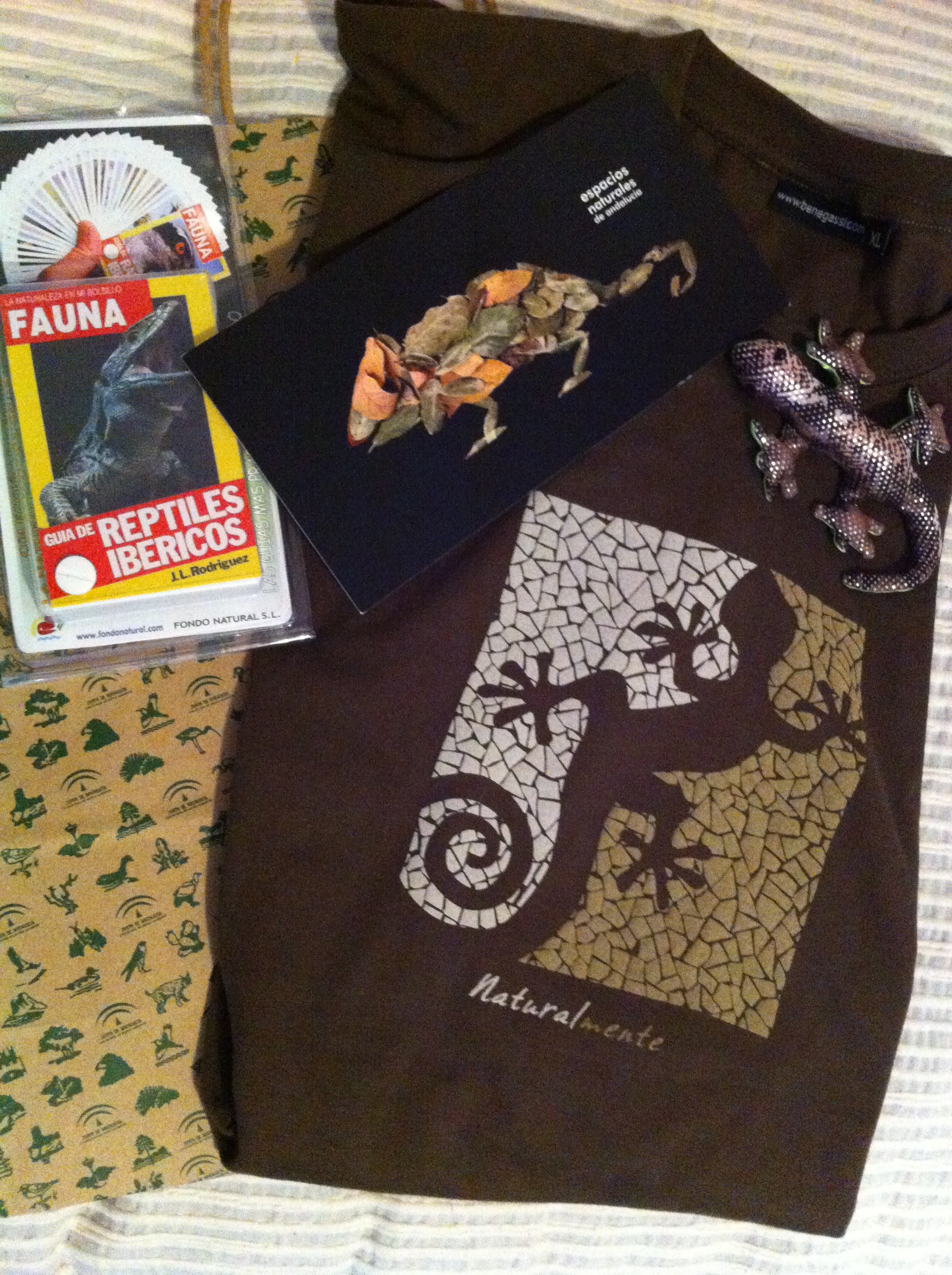 Up at the Torcal the shop at the Visitors' Centre came up trumps as I had known it would. I asked for a t-shirt with un lagarto (lizard) on it, and they had it in stock. Armed with that and a few other charming lizard-related items, I headed out to sit on the terrace awhile. The mother fox was out Up at the Torcal the shop at the Visitors' Centre came up trumps as I had known it would. I asked for a t-shirt with un lagarto (lizard) on it, and they had it in stock. Armed with that and a few other charming lizard-related items, I headed out to sit on the terrace awhile. The mother fox was out 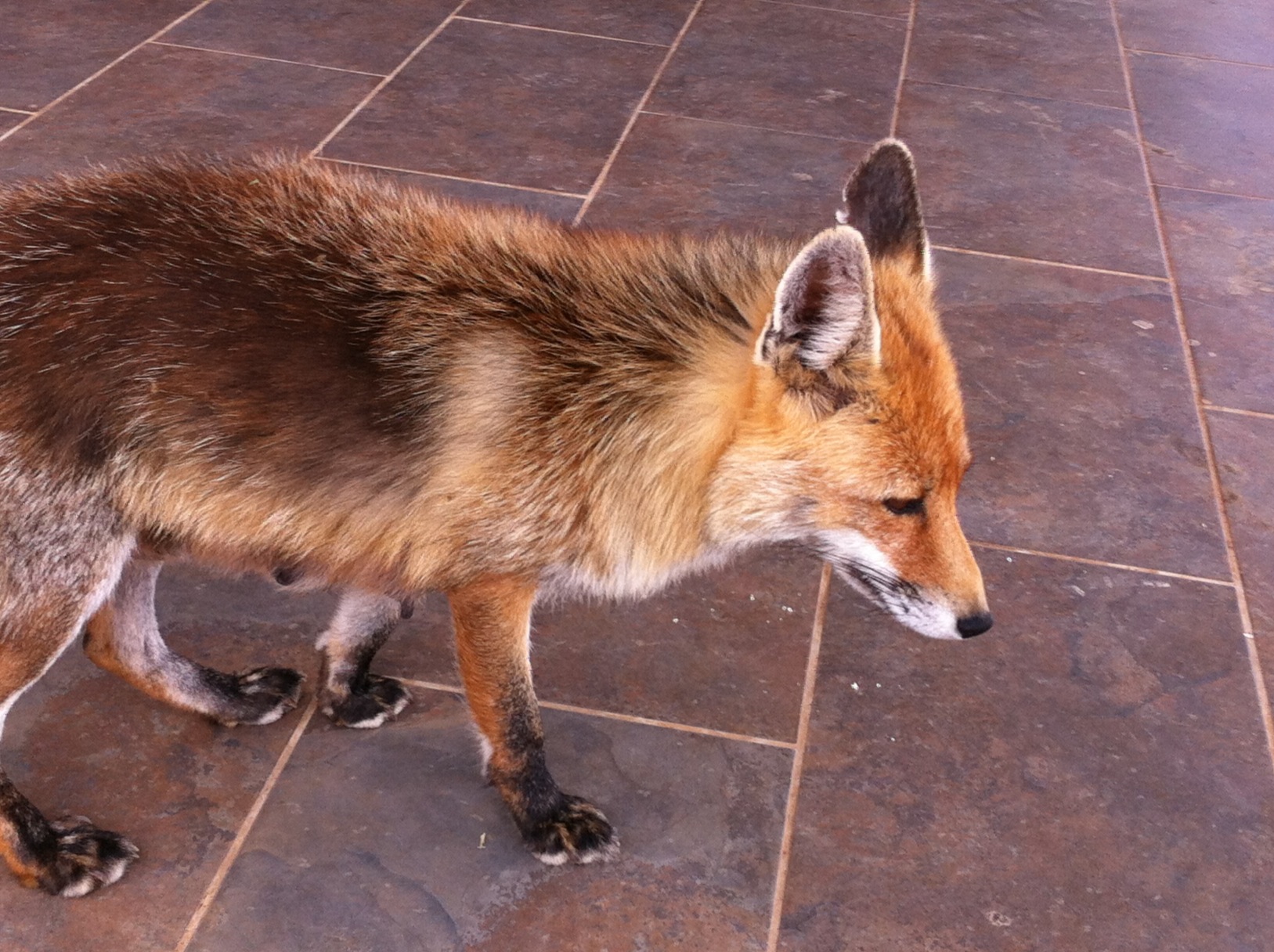 there scrounging food as usual. Healthy and happy with her shiny coat she is a popular fixture outside the café, collecting food to take back to her cubs. I had a garlicky tomato salad and a good coffee - well, the 40-minute journey had taken an hour and a half so I deserved a break. there scrounging food as usual. Healthy and happy with her shiny coat she is a popular fixture outside the café, collecting food to take back to her cubs. I had a garlicky tomato salad and a good coffee - well, the 40-minute journey had taken an hour and a half so I deserved a break.
A quick walk out to the Mirador - it's a view that never disappoints. Even in the cloud, the extraordinary rock formations take on a different rather spooky atmosphere.
.jpg) Back in the car and I headed downhill, the precious presents that weren't wedding presents stowed on the floor. The tractor towing the hay-bales pulled out just before I reached the big field entrance. I slowed behind him to about 5 kph. We crawled down the hill. No good even thinking about passing him, not on that narrow, winding road. An outcrop of colourful foliage caught my eye and I pulled over to take a snap. Within a couple of minutes I had caught up with the hay-bales again. Did you hear the joke about the magic tractor? It drove along the road and turned into a field. Boom-boom! Except this one didn't - it carried on ahead of me for another fifteen minutes before finally doing the magic trick and turning into a lay-by. Back in the car and I headed downhill, the precious presents that weren't wedding presents stowed on the floor. The tractor towing the hay-bales pulled out just before I reached the big field entrance. I slowed behind him to about 5 kph. We crawled down the hill. No good even thinking about passing him, not on that narrow, winding road. An outcrop of colourful foliage caught my eye and I pulled over to take a snap. Within a couple of minutes I had caught up with the hay-bales again. Did you hear the joke about the magic tractor? It drove along the road and turned into a field. Boom-boom! Except this one didn't - it carried on ahead of me for another fifteen minutes before finally doing the magic trick and turning into a lay-by.
Near the soaring arches of the flyover a scrawny cat with a kitten in her mouth hovered by the side of the road, unsure whether to cross or not. I pulled over a good distance before her and used my car to block any traffic that might come along, while she took advantage and crossed over, dumped the kitten and went back for a second. I waited a moment to see if she needed another trip but she seemed settled so I set off again.
By Casabermeja I stopped by the side of the road to get oranges from the seller that I trust. "¿Para comer?" he asked. "No, para zumo" I replied. A 5-kilo sack for €3, and a pat on the head for his friendly dog.
Almost five hours after setting off, I carried my oranges and the wedding presents into the house. A trip to the shop successfully completed.
© Tamara Essex 2014
 1
Like
Published at 3:20 PM Comments (4)
1
Like
Published at 3:20 PM Comments (4)
Spam post or Abuse? Please let us know
|
|